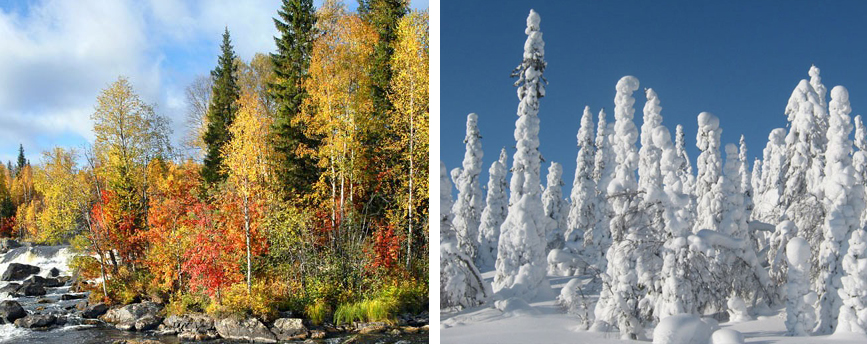Most of the Oulankajoki valley is covered with forest. Poor species diversity is characteristic for the sub-arctic boreal taiga, which consists mainly of spruce, pine and birch. Aspen grows on more fertile soils on hill slopes protected from the cold wind. In autumn it decorates the dark coniferous stands with bright red patches.
One can see willows and alders on the banks of rivers and streams mostly in the form of bushes. Ash and juniper are quite common on mires which speaks of nutrient-rich soils. Bird cherry trees blossom later in spring along rivers and streams.

Spruce stands occupy most of the area. Pine woods are rarer and grow mostly on fluvio-glacial sand-and-gravel sedimentary soils in the valleys of bigger rivers and sometimes on the plain with insufficient drainage. Thus pine woods are typical in the Oulankajoki valley. The largest parcel of pine forest is the water-glacial system of lake Paanajarvi – Olanga river.
The mountain forest is characterized by distinct vertical zoning: pine lichen and green-moss spruce forests grow on the hills slopes to the height 350-450 m above sea level. Then they are succeeded first by spruce-and-birch sparse forest, higher up – by mountain birch and finally by alpine tundra. On the northern flank of a large mountainous massif Sieppitunturi which lies on the northern border of the National Park alpine tundra descends down to 300 meters above sea level.
In the beginning of 20th century the timber on the shores of lake Paanajarvi and along Olanga river was felled for the needs of construction of the railway from St. -Petersburg to Murmansk. In view of the long distance of floating the old, the fire-scorched trees and trees with dead tops were left untouched. Today they are the oldest trees in the Olanga valley. Many of them are still alive. The age of some of these pines is over 400 or even 500 years.
Complete inventory of forests is yet to be done, but according to preliminary estimation about 60 per cent of the territory of Paanajarvi National Park is covered by undisturbed boreal forest. This is an exceptionally valuable nature complex of global importance since it is a refuge of many species of flora and fauna which had been irrevocably lost in other places due to wood felling.